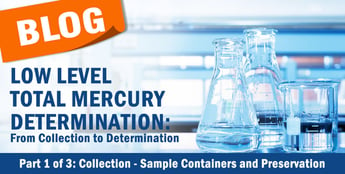
Mercury (Hg) determination at the ultra-trace level is an essential part of environmental assessment and drinking water monitoring. But this type of analysis comes with distinct challenges.
When working in the ultra-trace range, mercury is everywhere. Because of its persistent and pervasive nature, this toxic heavy metal is found all around us at low concentrations. When analyzing waters at levels down to the single digit parts-per-trillion (ppt), there are two main challenges:
- Preventing analyte loss from the sample,
- Avoiding contamination from outside sources.
Let’s begin with water sample collection. The type of container used to store the sample, the chemicals used for preservation, and the collection technique can affect the Hg level detected.
Mercury can diffuse in and out of certain materials. This can lead to results that are biased low or high, depending on the transference.
Laboratory equipment, like volumetric flasks, collection bottles, and digestion tubes, are commonly made with the materials listed below:
- Borosilicate glass
- Quartz
- Teflon (PTFE)
- Polypropylene (PP)
- High-density Polypropylene (HDPE)
- Polyethylene (PE)
The American Public Health Association and United States Environmental Protection Agency standard methods recommend collecting samples for Hg analysis in glass or fluoropolymer containers and preserving them either immediately or within 48 hours of collection with HNO3, HCl, BrCl, KBrO3, or KBr. Preserving the samples in acid or with an oxidizer stabilizes the Hg in the sample and prevents biological conversions to methylmercury. USEPA 1631, the most stringent drinking water analysis method, does allow for the digestion vessels to be PP or PE, since the duration of exposure is relatively short. Quality control measures like bottle blanks and equipment blanks help to ensure sampling devices and bottles are free from contamination. There are certified clean bottles and digestion tubes available on the market. But clean bottles alone aren’t enough. Good sampling techniques are imperative to obtaining reliable results. The ease of contaminating water samples cannot be overstressed.
When USEPA 1631 was released, it was accompanied by a guidance document that contains many techniques for preventing sample contamination.: Method 1669: Sampling Ambient Water for Determination of Trace Metals at EPA Water Quality Criteria Levels. This guide outlines an approach commonly referred to as “Clean Hands/Dirty Hands.” It involves a two-member sampling team where ”clean hands” is designated to touch only the sample bottle and control the transfer of the sample from the sample collection device. ”Dirty hands” is responsible for operating any apparatus required to obtain the sample and any activities that do not involve direct contact with the sample, like opening coolers and sample documentation. This can also be achieved by a single person wearing multiple layers of gloves.
Although the sampling and analytical processes can seem burdensome, they are necessary. To improve the reliability of trace-level mercury results, it is important to pay close attention, as seemingly small details can be very significant.
In my next blog, I will discuss the digestion process and chemicals involved for low-level mercury determination in waters.
For more information on Leeman Labs Mercury Analyzers or if you would like to someone to contact you - click the button below.

